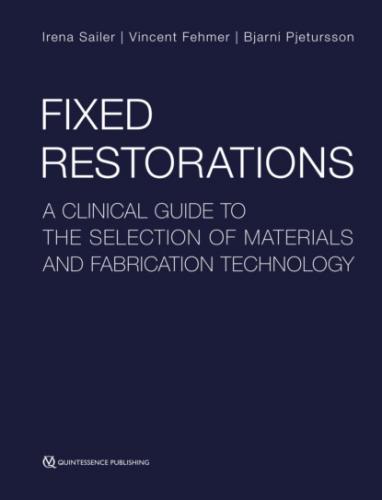Fixed Restorations. Irena Sailer
rel="nofollow" href="#fb3_img_img_8ab931d6-e07e-5c41-9bd6-a046ab3c3a22.jpg" alt=""/>
Fig 1-3-7k to 1-3-7n Final view of the microveneered lithium-disilicate restoration cemented to the titanium-base abutment with Multilink Hybrid Abutment HO-0 (Ivoclar Vivadent).
Material-specific limitations
Technicians and clinicians need to be aware of the material-specific strength and indications of the materials indicated for monolithic application. Hybrid materials like, for example, the polymer-infiltrated ceramic network (PICN) (Vita Enamic, Vita Zahnfabrik, Bad Säckingen, Germany), lithiumdisilicate glass-ceramic, and highly translucent zirconia exhibit strength values ranging from 250 up to 800 MPa (see Part I, Chapter 1). Compared to this, the yttria-stabilized zirconia polycrystals, used for framework fabrication, exhibit strength values of approximately 1500 MPa. Due to this reduced material stability, the indication of the latter materials is limited to single-unit application (Fig 1-3-8).
Fig 1-3-8a Initial situation of a missing first molar and the application of a spectrophotometer (Vita Easyshade, Vita Zahnfabrik) to transfer the reference tooth shade.
Fig 1-3-8b Final individualized monolithic PICN (Vita Enamic, Vita Zahnfabrik) restoration before cementation to the titanium-base abutment.
Fig 1-3-8c Final buccal view of the directly screw-retained, monolithic PICN restoration on a titanium-base abutment (Vario-Base for Cerec, Straumann).
Figs 1-3-8d to 1-3-8h Superficial individualization of the monolithic PICN restoration by the application of light-curing stain and glaze (Vita Enamic Stains, Vita Zahnfabrik).
Some manufacturers of translucent zirconia allow its use for short-span fixed dental prostheses with one pontic. In this case, the minimum dimensions of the cross-sections, as recommended by the respective manufacturer, need to be applied for sufficient clinical stability (Fig 1-3-9).
Fig 1-3-9a Initial situation after optical impression using intraoral camera (Trios3, 3Shape) for the fabrication of a four-unit monolithic zirconium oxide fixed dental prostheses (FDP) with mesial cantilever.
Fig 1-3-9b Digital design of the four-unit FDP using a CAD software (Exocad).
Fig 1-3-9c Try-in of the monolithic zirconium oxide FDP (Lava Plus, 3M, Seefeld, Germany) with super glue, temporarily cemented to the titanium-base abutments (Vario-Base, Straumann).
Fig 1-3-9d Final view of the superficial individualization (Ivocolor, Ivoclar Vivadent) of the monolithic zirconium oxide prior to cementation to the titanium-base abutments.
Fig 1-3-9e Final occlusal view of the direct screw-retained, monolithic zirconium oxide FDP on titanium-base abutments (Vario-Base, Straumann).
Options for surface modification
If the reference teeth exhibit pronounced surface microtexture (eg, perikymata), the mimicking may be technically difficult with monolithic ceramics. Reinforced glassceramics and zirconia exhibit high surface hardness and can only be surface-individualized with diamond-coated instruments; the texture may then be smoothened by the application of glaze ceramic. The facial application of softer veneering ceramic is recommended in these situations.
Abrasion/wear properties
The monolithic materials are industrially fabricated and exhibit optimal quality and integrity, with no pores16,17. Yet, their hardness has been questioned and a higher risk for abrasion and wear of the antagonists was assumed for the monolithic restorations (Fig 1-3-10).
Fig 1-3-10a Detailed microscopic image of a conventionally veneered zirconium oxide restoration after a simulated 5 years of aging. The traces of abrasion and the exposure of individual porosities can already be seen very clearly.
Fig 1-3-10b Detailed microscopic image of a monolithic zirconium oxide restoration after a simulated 5 years of aging.
Fig 1-3-10c Detailed microscopic image of a monolithic lithium-disilicate restoration after a simulated 5 years of aging.
Fig 1-3-10d Detailed microscopic image of a monolithic PICN restoration after a simulated 5 years of aging.
It has been shown, indeed, that these technical processing steps are crucial for the abrasiveness of monolithic restorations. High-gloss polished lithium-disilicate and zirconia lead to very low abrasions with the antagonistic teeth or restorative materials18,19. Yet, intaglio, rough, and stained and glazed monolithic ceramics induce pronounced wear of the antagonists, as studies have shown.
Hence, monolithic restorations should always only be high gloss polished in the occlusal and functional areas, and may be veneered, colored, and/or glazed on the buccal and oral parts.
1. Beuer F, Schweiger J, Edelhoff D. Digital dentistry: an overview of recent developments for CAD/CAM generated restorations. Br Dent J 2008;204:505–511.
2. Miyazaki T, Hotta Y, Kunii J, Kuriyama S, Tamaki Y. A review of dental CAD/CAM: current status and future perspectives from 20 years of experience. Dent Mater J 2009;28:44–56.
